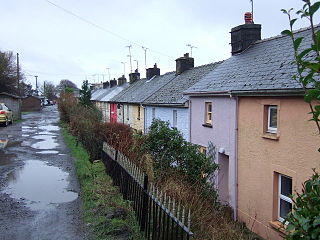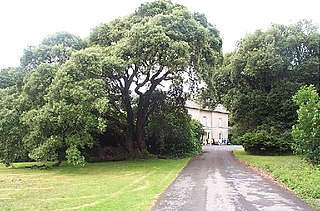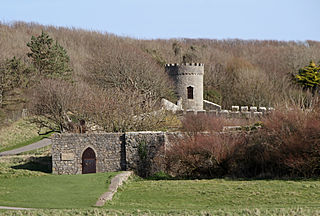
The TARDIS is a fictional hybrid of the time machine and spacecraft that appears in the British science fiction television series Doctor Who and its various spin-offs. Its exterior appearance mimics a police box, an obsolete type of telephone kiosk that was once commonly seen on streets in Britain. Paradoxically, its interior is shown as being much larger than its exterior, commonly described as being "bigger on the inside".

The Westgate Hotel, Commercial Street, Newport, Wales is a hotel building dating from the 19th century. On 4 November 1839 the hotel saw the major scenes of the Newport Rising, when 3,000 Chartists, some of them armed, led by John Frost marched on Newport to attempt to secure the release of five of their number who were being held under arrest at the hotel. In the fighting between about 60 soldiers of the 45th Regiment of Foot and police on one side, and a larger number of Chartists on the other, 10-22 Chartists were killed and more than 50 wounded. The hotel is a Grade II listed building.

The red telephone box, a telephone kiosk for a public telephone designed by Sir Giles Gilbert Scott, is a familiar sight on the streets of the United Kingdom, Malta, Bermuda and Gibraltar.

A police box is a public telephone kiosk or callbox for the use of members of the police, or for members of the public to contact the police. It was used in some countries, most widely in the United Kingdom throughout the 20th century from the early 1920s. Unlike an ordinary callbox, its telephone was located behind a hinged door so it could be used from the outside, and the interior of the box was, in effect, a miniature police station for use by police officers to read and fill in reports, take meal breaks and even temporarily hold detainees until the arrival of transport.

Colwyn Bay is a town, community and seaside resort in Conwy County Borough on the north coast of Wales overlooking the Irish Sea. It lies within the historic county of Denbighshire. Eight neighbouring communities are incorporated within its postal district. Established as its own separate parish in 1844 with just a small grouping of homes and farms where the community of Old Colwyn stands today, Colwyn Bay has expanded to become the second-largest community and business centre in the north of Wales as well as the 14th largest in the whole of Wales with the urban statistical area, including Old Colwyn, Rhos-on-Sea, and Mochdre and Penrhyn Bay, having a population of 34,284 at the 2011 census.

The Newport Transporter Bridge is a transporter bridge that crosses the River Usk in Newport, South East Wales. The bridge is the lowest crossing on the River Usk. It is a Grade I listed structure.

Raglan (; is a village and community in Monmouthshire, south east Wales, United Kingdom. It is located some 9 miles south-west of Monmouth, midway between Monmouth and Abergavenny on the A40 road very near to the junction with the A449 road. The fame of the village derives from Raglan Castle, built for William ap Thomas and now maintained by Cadw. The community includes the villages of Llandenny and Pen-y-clawdd. Raglan itself has a population of 1,183.

Rosebush is a small village in the community of Maenclochog, Pembrokeshire, southwest Wales, UK. It lies in the southern slopes of the Preseli Hills, about 1 mile (1.6 km) north west of the village of Maenclochog. Slate was extensively quarried nearby, and was exported by the Narberth Road and Maenclochog Railway, which was later extended towards Fishguard. Today, Rosebush is a centre for exploring the Preseli Hills.

Dyffryn Gardens, also spelt Duffryn Gardens, is a collection of botanical gardens located near the villages of Dyffryn and St. Nicholas in the Vale of Glamorgan, Wales. The gardens were selected by the British Tourist Authority as one of the Top 100 gardens in the UK and are in the care of the National Trust. They are designated at Grade I, the highest grade, on the Cadw/ICOMOS Register of Parks and Gardens of Special Historic Interest in Wales.
Eglwyswrw[ɛɡlʊɨˈsuːrʊ] is a village, community and parish in the former Cantref of Cemais, Pembrokeshire, Wales. The village lies between Newport and Cardigan at the junction of the A487 road and the B4332 at an altitude of 130 metres (430 ft).

The former Newport Odeon, currently trading as The NEON, is a large Grade II listed building in the city of Newport, South Wales.

The Cathays Cemetery is one of the main cemeteries of Cardiff, Wales. It is in the Cathays district of the city, about 1.5 miles (2.4 km) north of Cardiff city centre. At 110 acres it is the third largest cemetery in the United Kingdom. It is listed on the Cadw/ICOMOS Register of Parks and Gardens of Special Historic Interest in Wales.

Bedwellty House is a Grade II-listed house and gardens in Tredegar, in the Sirhowy Valley in south-east Wales. It was built in the early 19th century on the site of an earlier building and subsequently enlarged into its present form by mid-century. The owners donated the house and its grounds to the public at the beginning of the 20th century. They were restored at the beginning of the 21st century. The grounds are included on the Cadw/ICOMOS Register of Parks and Gardens of Special Historic Interest in Wales, the only estate so listed in Blaenau Gwent.

Llangattock is a village, community and electoral ward in the Brecon Beacons National Park in Powys, Wales. It lies in the Usk Valley just across the river from the town of Crickhowell. The Monmouthshire and Brecon Canal passes through the village en route between Brecon and Pontypool. It is in the historic county of Breconshire.

Scolton Manor is a Victorian country house and country park located in Pembrokeshire, West Wales northeast of Haverfordwest and on the borders of the Pembrokeshire Coast National Park. Built as a home, it is now a museum and is a Grade II* listed building. The stable court, some 120 m (130 yd) to the north, is also a Grade II listed building and both are owned by Pembrokeshire County Council. The gardens and parkland are listed on the Cadw/ICOMOS Register of Parks and Gardens of Special Historic Interest in Wales. The house, grounds and a number of exhibits are open to the public.

Dunraven Castle was a mansion on the South Wales coast near Southerndown. The existing manor house was rebuilt as a castellated hunting lodge in the early 19th century and was extensively remodelled later in the century. The surviving parts of the house are a Grade II listed building and its gardens and park are designated Grade II on the Cadw/ICOMOS Register of Parks and Gardens of Special Historic Interest in Wales.

Cwm Gwaun is a community and valley in north Pembrokeshire, Wales. The community is centred around Pontfaen, a parish and hamlet 4 miles (6.4 km) southeast of Fishguard, and includes the ancient parish of Llanychaer. In 2011, the population was 313. The valley is known for its unspoilt nature and old-world pub, and there are numerous other listed buildings.

Penhow Castle, Penhow, Newport dates from the early 12th century. Extended and reconstructed in almost every century since, it has been claimed to be the oldest continuously-inhabited castle in Wales. The castle is a Grade II* listed building.
TARDIS is a fictional time machine and spacecraft in the television programme Doctor Who and its associated spin-offs.

There are many listed buildings in Penarth, a seaside town in the Vale of Glamorgan, Wales. Penarth was popular with holidaymakers from far afield, but also a popular place to live for the wealthy business owners of Penarth and nearby Cardiff. The town has a wealth of Victorian and Edwardian architecture.




















